The Effect of OMMT on the Properties of Vehicle Damping Carbon Black-Natural Rubber Composites
Abstract
1. Introduction
2. Experiment Section
2.1. Materials and Preparation
2.2. Measurements
2.2.1. Processing Performance
2.2.2. Mechanical Tests
2.2.3. Rubber Processing Analysis (RPA)
2.2.4. Dynamic Mechanical Analysis (DMA)
2.2.5. Scanning Electron Microscope (SEM)
3. Results and Discussion
3.1. Vulcanization Performance
3.2. Mechanical Properties
3.3. Dynamic Mechanical Performance
3.4. Microstructural Characterization
4. Conclusions
Author Contributions
Funding
Acknowledgments
Conflicts of Interest
References
- Essawy, H.A.; El-Sabbagh, S.H.; Tawfik, M.E. Assessment of provoked compatibility of NBR/SBR polymer blend with montmorillonite amphiphiles from the thermal degradation kinetics. Polym. Bull. 2018, 75, 1417–1430. [Google Scholar] [CrossRef]
- Fleischmann, D.D.; Ayalur, K.S.; Arbeiter, F. Influence of crosslinker and water on mechanical properties of carboxylated nitrile butadiene rubber (XNBR). Polym. Test. 2018, 66, 24–31. [Google Scholar] [CrossRef]
- Lang, Z.Q.; Jing, X.J.; Billings, S.A. Theoretical study of the effects of nonlinear viscous damping on vibration isolation of SDOF systems. J. Sound Vib. 2009, 323, 352–365. [Google Scholar] [CrossRef]
- Gao, F.N. The application of silane coupling agent in rubber sealing products and shock absorbing products. Rubber Technol. Mark. 2009, 23, 11–13. [Google Scholar]
- Urayama, K.; Miki, T.; Takigawa, T.; Shinzo, K. Damping elastomer based on model irregular networks of end-linked poly (dimethylsiloxane). Chem. Mater. 2004, 16, 173–178. [Google Scholar] [CrossRef]
- Yamazaki, H.; Takeda, M.; Kohno, Y.; Ando, H.; Urayama, K.; Takigawa, T. Dynamic viscoelasticity of poly (butyl acrylate) elastomers containing dangling chains with controlled lengths. Macromolecules 2011, 4, 8829–8834. [Google Scholar] [CrossRef]
- Wang, Z.R. Japan patent collection of shock absorbing rubber products. World Rubber Ind. 2001, 28, 27–32. [Google Scholar]
- Zhang, X.L.; Liang, D.; Zhao, S.G. Study on vulcanization kinetics and properties of natural rubber damping damping materials by vulcanization system. Rubber Ind. 2018, 65, 845–849. [Google Scholar]
- Liu, C.; Fan, J.F.; Chen, Y.K. Design of regulable chlorobutyl rubber damping materials with high damping value for a wide temperature range. Polym. Test. 2019, 79, 106003. [Google Scholar] [CrossRef]
- Wang, J.G.; Ren, H.; Wang, S.J.; Wei, J.J.; Ren, H.; Xue, M.L. Effect of rubber alloy SG-301 on properties of natural rubber/nitrile rubber damping material. China Synth. Rubber Ind. 2018, 41, 420–424. [Google Scholar]
- Li, B.; Zhang, B.S.; Yang, L.B.; Tang, J.H.; Liu, H.P. Effect of carbon black on the properties of high damping natural rubber/bromobutyl rubber and rubber. Rubber Ind. 2018, 65, 665–668. [Google Scholar]
- Litvinov, V.M.; Orza, R.A.; Kluppel, M.; Van Duin, M.; Magusin, P.C.M.M. Rubber-filler interactions and network structure in relation to stress-strain behavior of vulcanized, carbon black filled EPDM. Macromolecules 2011, 44, 4887–4900. [Google Scholar] [CrossRef]
- Liu, Q.X.; Ding, X.B.; Zhang, H.P.; Yan, X. Preparation of high-performance damping materials based on carboxylated nitrile rubber: Combination of organic hybridization and fiber reinforcement. J. Appl. Polym. Sci. 2009, 114, 2655–2661. [Google Scholar] [CrossRef]
- Sinclair, A.; Zhou, X.Y.; Tangpong, S.; Bajwa, D.S.; Quadir, M.; Jiang, L. High-Performance styrene-butadiene rubber nanocomposites reinforced by surface-modified cellulose nanofibers. ACS Omega 2019, 4, 13189–13199. [Google Scholar] [CrossRef] [PubMed]
- Noor Azammi, A.M.; Sapuan, S.M.; Ishak, M.R.; Sultan, M.T. Physical and damping properties of kenaf fibre filled natural rubber/ thermoplastic polyurethane composites. Def. Technol. 2020, 16, 29–34. [Google Scholar] [CrossRef]
- Joseph, S.; Sreekumar, P.A.; Kenny, J.M.; Puglia, D.; Thomas, S.; Joseph, K. Dynamic Mechanical Analysis of Oil Palm Microfibril-Reinforced Acrylonitrile Butadiene Rubber Composites. Polym. Compos. 2010, 31, 236–244. [Google Scholar] [CrossRef]
- Guo, Y.B.; Tan, H.; Gao, Z.Q.; Wang, D.; Zhang, S. Mechanical and unlubricated sliding wear properties of nitrile rubber reinforced with mico glass flake. Polymers 2018, 10, 705. [Google Scholar] [CrossRef]
- Perera, M.C.S.; Wen, C.C. Radiation degradation of MG rubber studied by dynamic mechanical analysis and solid state NMR. Polymers 2000, 41, 323. [Google Scholar] [CrossRef]
- Xu, K.M.; Hu, Q.M.; Wu, H.; Guo, S.; Zhang, F. Designing a polymer-based hybrid with simultaneously improved mechanical and damping properties via a multilayer structure construction: Structure evolution and a damping mechanism. Polymers 2020, 12, 446. [Google Scholar] [CrossRef]
- Zhang, Z.L.; Wang, P.; Cheng, K.; Xin, C.; Zhang, Z.; Li, Z. Delayed expansion behavior and mechanical properties of water-swelling rubber/OMMT composites. J. Macromol. Sci. Part A 2020, 57, 610–617. [Google Scholar] [CrossRef]
- Chen, S.B.; Wang, Q.H.; Wang, T.M. Damping, thermal, and mechanical properties of carbon nanotubes modifed castor oil-based polyurethane/epoxy interpenetrating polymer network composites. Mater. Des. 2012, 38, 47–52. [Google Scholar] [CrossRef]
- Chen, S.B.; Wang, Q.H.; Wang, T.M. Damping, thermal, and mechanical properties of montmorillonite modifed castor oil-based polyurethane/epoxy graft IPN composites. Mater. Chem. Phys. 2011, 130, 680–684. [Google Scholar] [CrossRef]
- Payne, A.R. Reinforcement of Elastomers; Kraus, G., Ed.; Inter Science Publishers: New York, NY, USA, 1965; Volume 3, p. 69. [Google Scholar]
- Payne, A.R. The dynamic properties of carbon black-loaded natural rubber vulcanizates. J. Appl. Polym. Sci. 1962, 6, 57–63. [Google Scholar] [CrossRef]
- Payne, A.R. Effect of dispersion on the dynamic properties of filler-loaded rubbers. J. Appl. Polym. Sci. 1965, 9, 2273–2284. [Google Scholar] [CrossRef]
- Choi, S.S. Filler-polymer interactions in both silica and carbon black-filled styrene-butadiene rubber compounds. J. Polym. Sci. Part B Polym. Phys. 2001, 39, 439–445. [Google Scholar] [CrossRef]
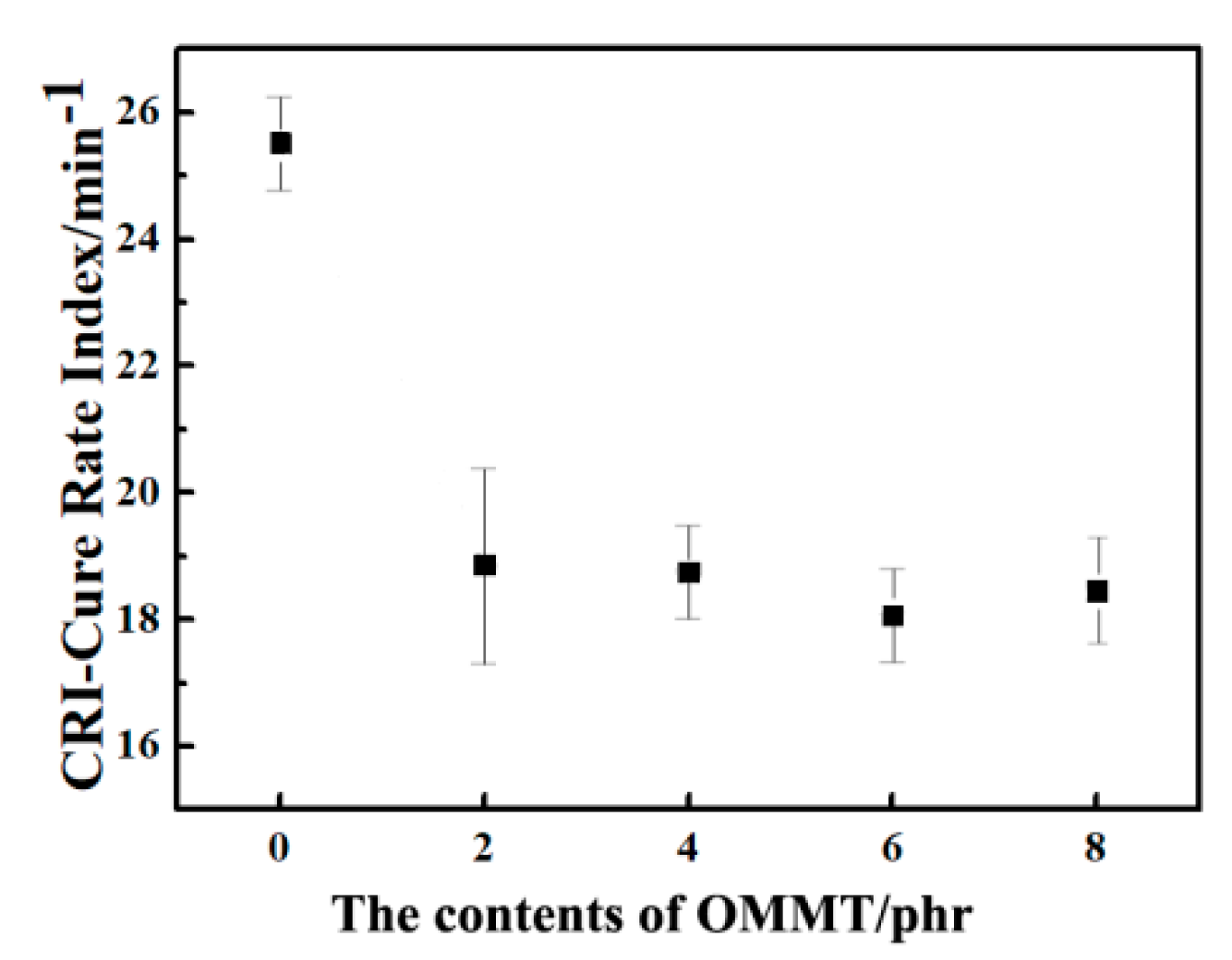
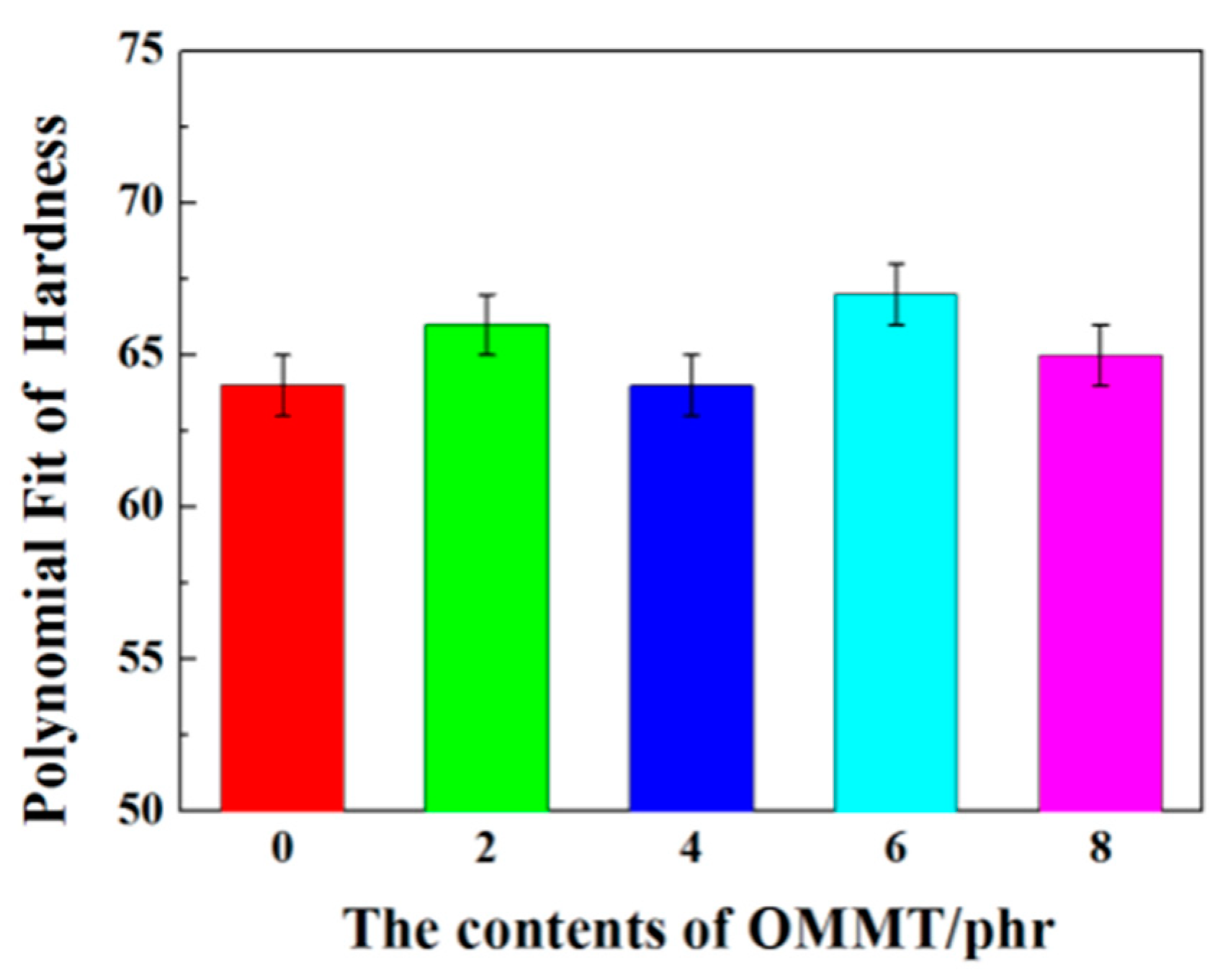
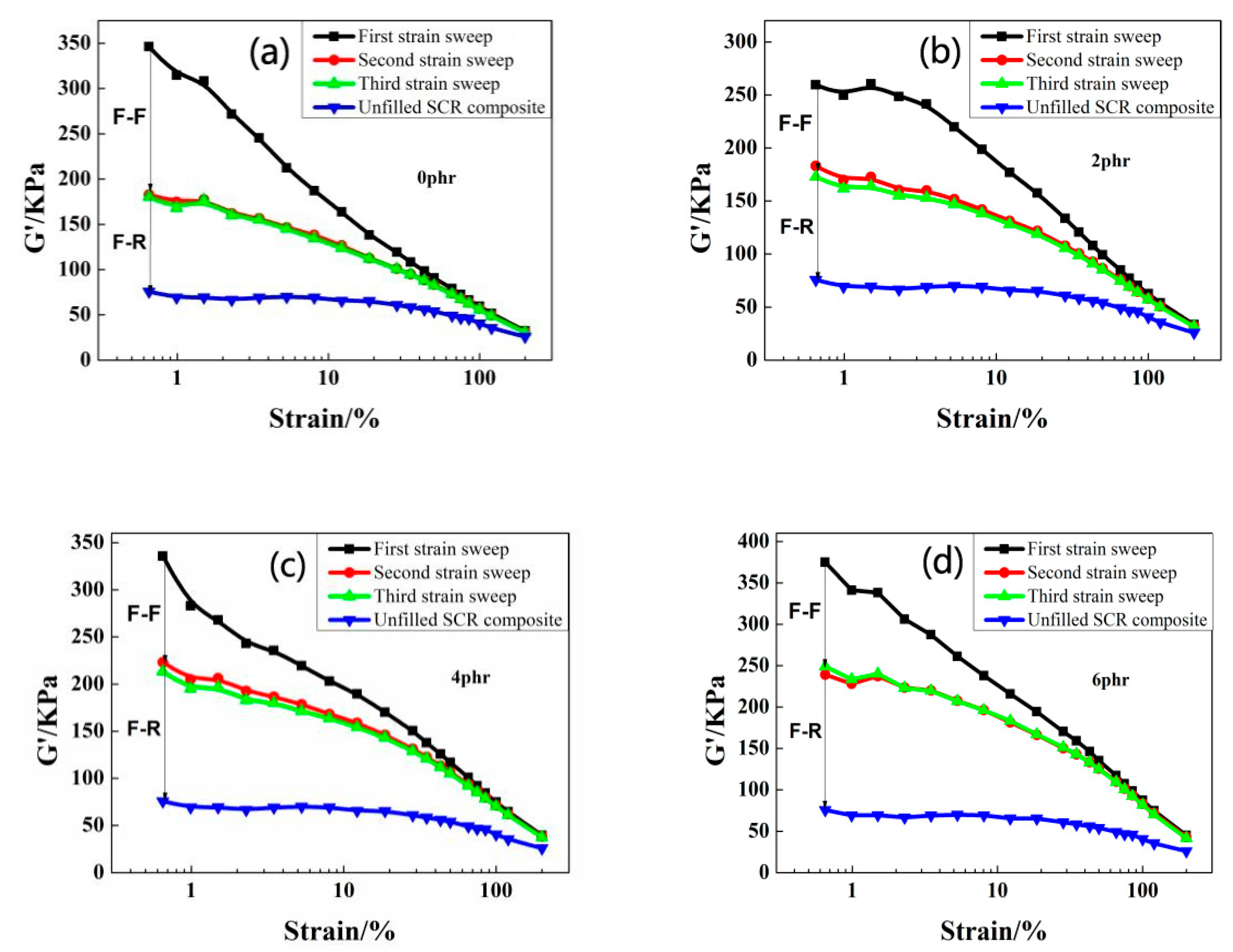


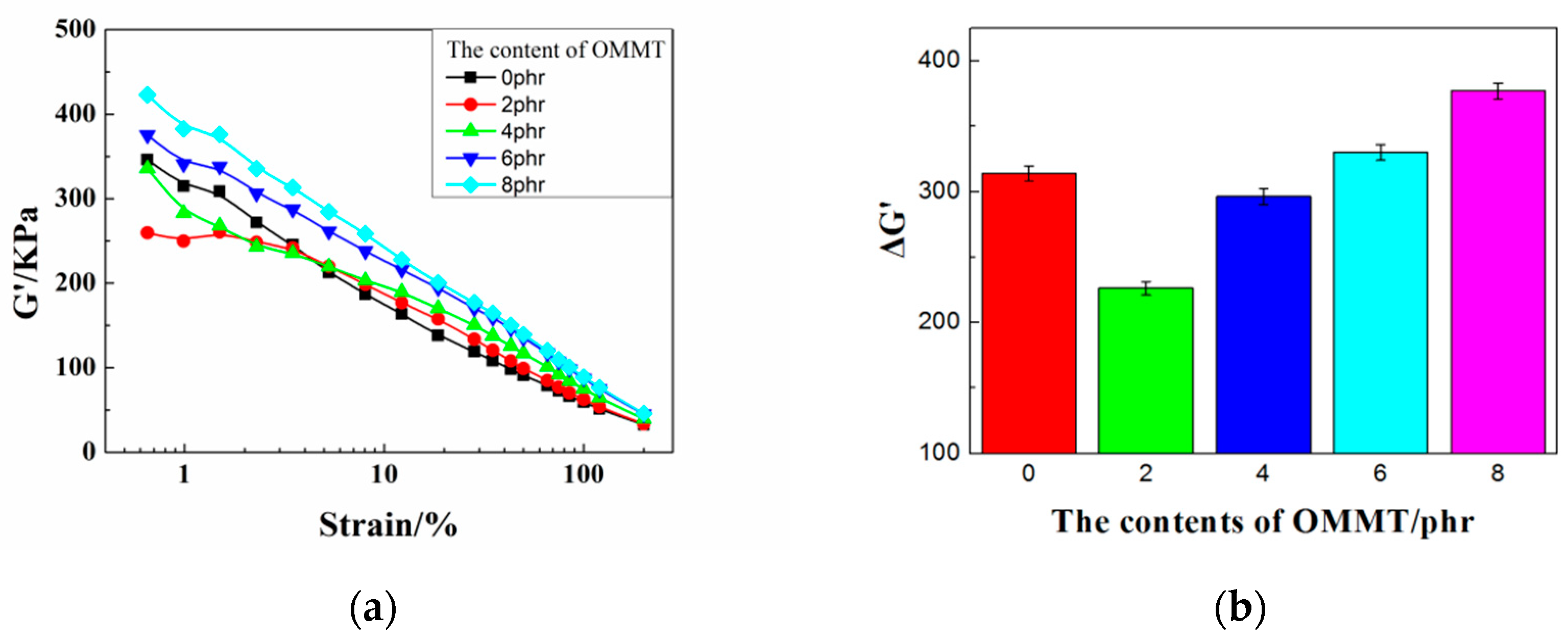
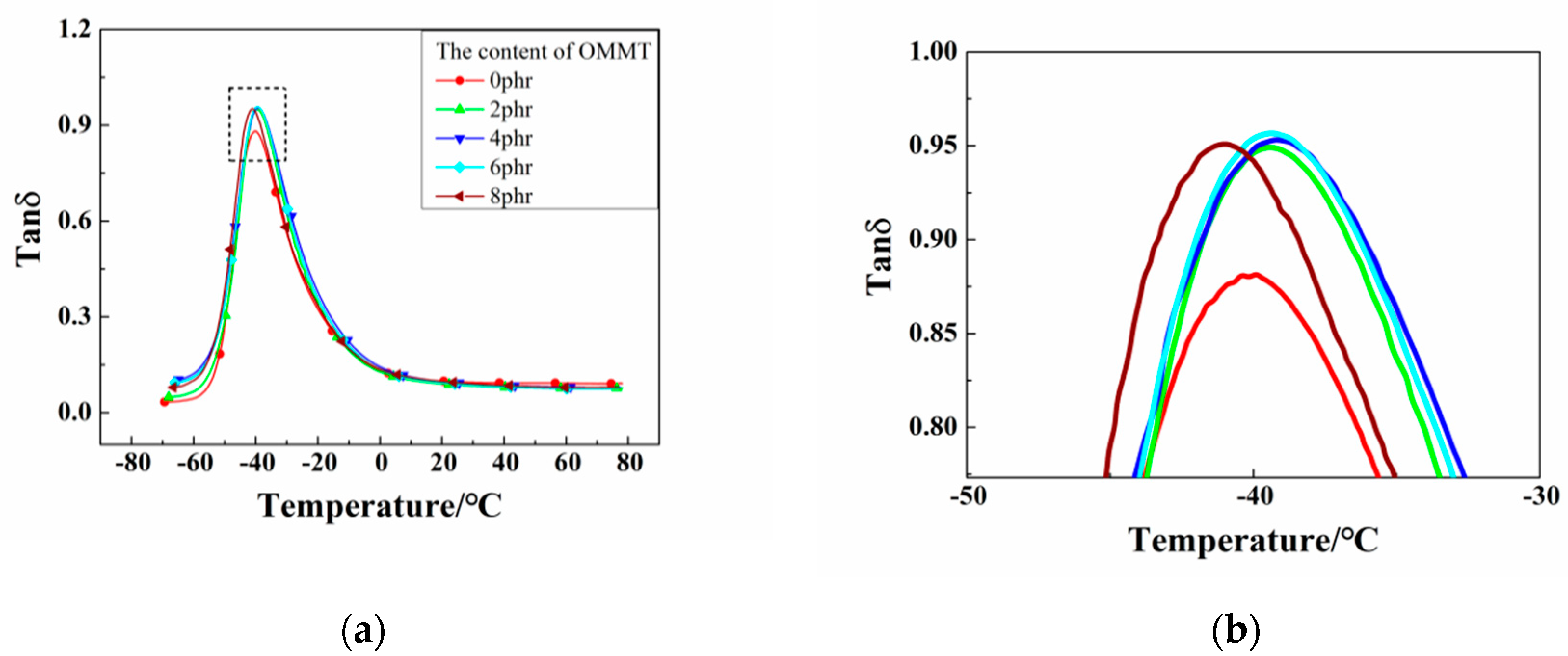

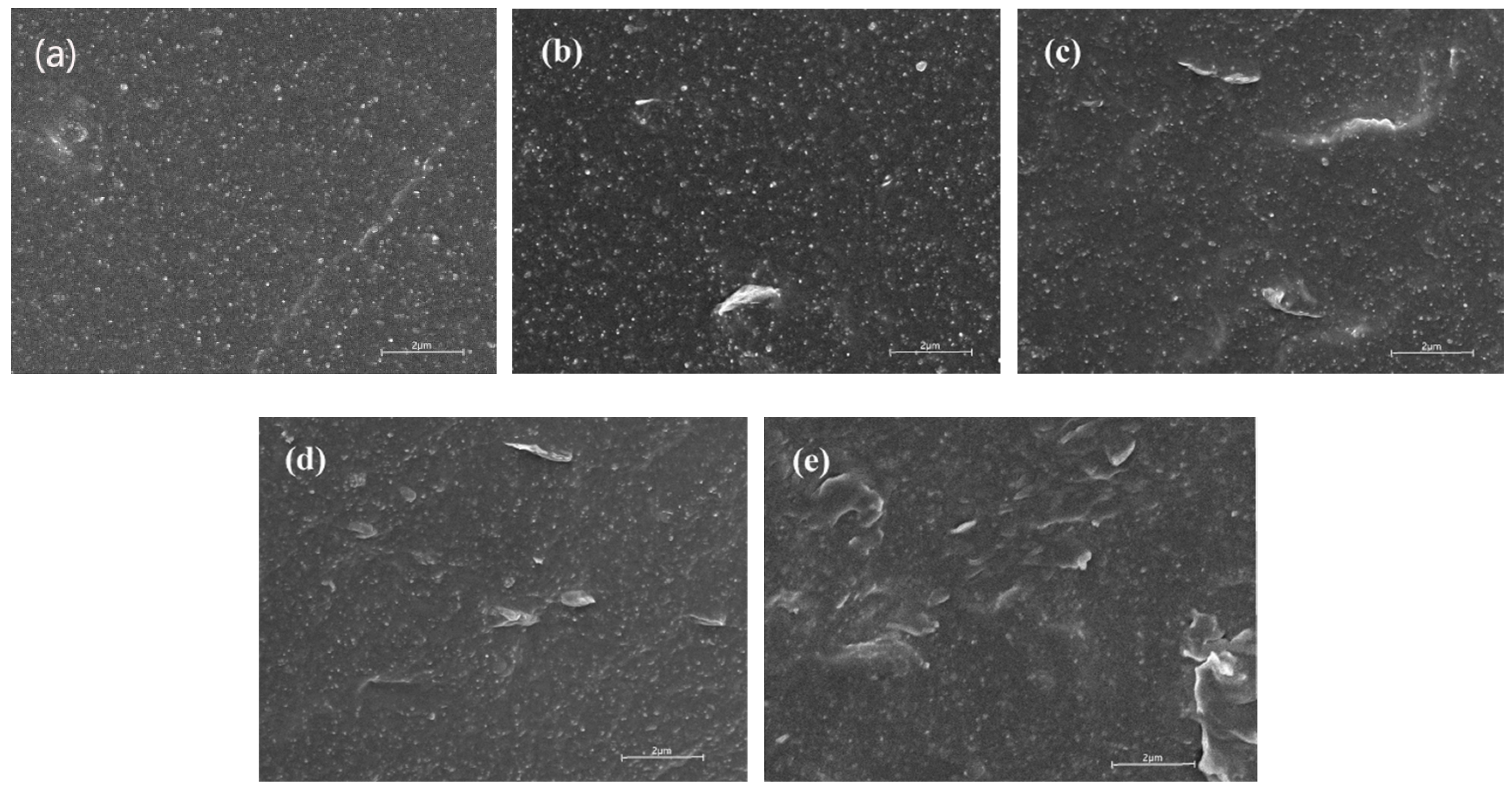
| Ingredient | NR | Sulfur | ZnO | Stearic Acid | Microcrystalline Wax | CTP | 4020 | RD | N330 | OMMT |
|---|---|---|---|---|---|---|---|---|---|---|
| Phr | 100 | 2 | 5 | 1 | 1 | 1 | 3 | 1 | 50 | 0/2/4/6/8 |
| The Content of OMMT/phr | 0 | 2 | 4 | 6 | 8 |
|---|---|---|---|---|---|
| Tensile Strength/MPa | 27.5 | 27.6 | 25.2 | 25.6 | 24.4 |
| Elongation/% | 616 | 502 | 519 | 515 | 488 |
| Tensile Strength at 100%/MPa | 2.1 | 3.2 | 2.7 | 2.8 | 2.8 |
| Tensile Strength at 300%/MPa | 11.0 | 15.0 | 12.4 | 12.9 | 13.2 |
| Elasticity Modulus/MPa | 2.6 | 3.4 | 2.9 | 3.1 | 3.2 |
| Tear Strength/kN/m | 131.9 | 111.9 | 111.3 | 96.6 | 87.0 |
| Resilience Property/% | 47.7 | 51.9 | 51.4 | 52.0 | 51.4 |
| OMMT/phr | Final Temperature Rise/°C | Dynamic Compression Permanent Deformation/% | Static Compression Permanent Deformation/% |
|---|---|---|---|
| 0 | 15.85 | 0.060 | 0.093 |
| 2 | 13.90 | 0.040 | 0.091 |
| 4 | 14.25 | 0.051 | 0.083 |
| 6 | 15.30 | 0.055 | 0.081 |
| 8 | 15.80 | 0.045 | 0.072 |
© 2020 by the authors. Licensee MDPI, Basel, Switzerland. This article is an open access article distributed under the terms and conditions of the Creative Commons Attribution (CC BY) license (http://creativecommons.org/licenses/by/4.0/).
Share and Cite
Liu, W.; Lv, L.; Yang, Z.; Zheng, Y.; Wang, H. The Effect of OMMT on the Properties of Vehicle Damping Carbon Black-Natural Rubber Composites. Polymers 2020, 12, 1983. https://doi.org/10.3390/polym12091983
Liu W, Lv L, Yang Z, Zheng Y, Wang H. The Effect of OMMT on the Properties of Vehicle Damping Carbon Black-Natural Rubber Composites. Polymers. 2020; 12(9):1983. https://doi.org/10.3390/polym12091983
Chicago/Turabian StyleLiu, Wei, Lutao Lv, Zonglin Yang, Yuqing Zheng, and Hui Wang. 2020. "The Effect of OMMT on the Properties of Vehicle Damping Carbon Black-Natural Rubber Composites" Polymers 12, no. 9: 1983. https://doi.org/10.3390/polym12091983
APA StyleLiu, W., Lv, L., Yang, Z., Zheng, Y., & Wang, H. (2020). The Effect of OMMT on the Properties of Vehicle Damping Carbon Black-Natural Rubber Composites. Polymers, 12(9), 1983. https://doi.org/10.3390/polym12091983





